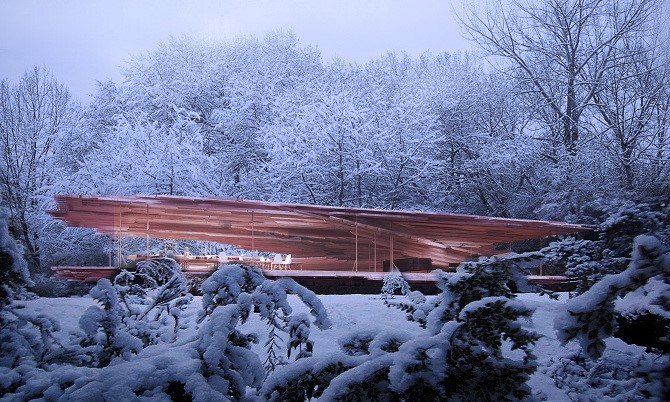NEWS
Housing in 2049: what will tomorrow's housing look like?
On September 25, a conference on the housing of the future was held at the Pavillon de l’Arsenal. This conference is part of a series of meetings and discussions organized by the newsmagazine "l'Obs", with the objective of examining the environmental challenges we will have to face in 2049, as human beings, as families, and as a society. This article is a summary of this conference that explored future scenarios through the eyes of experts, researchers, and sociologists.
Automating architectural construction
Automation is a technique that has benefited a large number of industries (retail, automotive, pharmaceutical, etc.) by improving productivity while reducing labor costs. But other sectors such as construction and architecture have not yet benefited from it, and are constrained by rules that have remained unchanged since 1947. This is the first observation made by Gilles Retsin, a Belgian architect based in London. As an "automated architect", he has based his work on automating architectural construction, on the one hand in the creation of easily assembled blocks, and on the other hand in the generation of unusual structures by computer.
Gilles Retsin also notes that the purchase price of real estate will continue to rise in the face of the urban densification and speculation that we are seeing today in major megacities such as Paris, London, Berlin, New York, and Tokyo. On the other hand, the construction times of new housing discourage buyers who prefer to fall back on the old, more energy-intensive, often more expensive, certainly less ecological housing stock. At the same time, Airbnb and Google are starting to build their own increasingly intelligent buildings (such as Toronto's Google City, designed by Sidewalk Labs, Alphabet's urban innovation subsidiary) that will capture the everyday, trivial data of their residents. There will be no more houses, just services.
Faced with these pessimistic observations, Gilles has a plan: to make ownership and even rental accessible to all by taking into account the new modularities of household structures (blended families, divorces, growing celibacy). He also wants to accelerate housing construction processes so as not to segregate populations and leave the field open to the GAFAs. To move from a very analogous, sequenced construction schema to a modular construction model that could be assembled as quickly as pixels. To do this, he intervenes in programming languages as well as on production processes: he imagines an architectural structure (housing, artwork, cultural space) that he cuts up into blocks. Each block is 3D printed and assembled with its other congeneric and co-generated blocks thanks to many small robots. The materials used are lighter, easier to assemble, less expensive, and the construction requires little labor.
Computer-aided construction and automation make it possible to increase the versatility of buildings, reduce production costs, and thus facilitate access to housing. 3D printing offers digital materiality prospects for the customization and modularity of the home that we do not have today with our standardized construction schemas.

Blokhut, 2015, Gilles Retsin
Rethinking the construction and development schemas of housing with the evolution of lifestyles and meeting places
This is the subject of research by Monique Eleb, sociologist and housing specialist.
It reminds us that in 2050, 1 in 3 people will be over 60 years old, and that today, 36% of people in France are single, 53% in Paris. By 2049, teleworking will almost become standard (or it will already be so?), the number of divorces will only increase, and thanks to the PMA, we will see more and more two-person households.
We led ourselves to dream that housing would evolve and old-age with our age, and that the modal family that we thought was unchangeable would never be reduced to its simplest form: codes so deeply rooted in the structuring and design of cities and housing must now be contravened (the regulation size of a room was designed on the basis of the size that a car should have).
Monique Eleb emphasizes that tomorrow's housing must be flexible, adaptable, and reversible for the different ages and stages of people's lives. Concerning teleworking: it is necessary to be able to have an office that is not in the living room to separate the work and break areas. Then if parenting arrives: to be able to transform a relaxation space into a bedroom. When the parents recover their duality (when the child leaves the nest): to be able to transform the space back into an activity space. Then when the time comes for solitude (due to someone leaving or dying): transform part of the space formerly occupied into a rentable space to optimize the return on the rent (following someone leaving or dying)
She highlights the fact that common areas (terraces, playgrounds, shopping centers) must be at the center of residential areas to avoid the "zoning" and loneliness of large cities. In short, it is urgent to put people back in the center of the concerns of developers, cities, and public policies in order to optimize territorial planning and avoid the melancholy of urban solitudes.
Imagining and creating the homes of the future
Benjamin Delaux, President of Habx, wanted to reinvent the design and marketing of new housing with his start-up. Their platform allows buyers to customize their apartment before the building is built. They are responsible for taking into account the production capacities of property developers to meet the needs of the future owners (transport, workplaces, green spaces, leisure). They are developing three algorithms that will determine the best possible location, to match expectations with available real-estate programs, and also to allow future buyers to design the layout of their future home themselves.
Housing in 2049 will therefore be human-centered but will also be ecological. This is the challenge of Timothée Boitouzet, President of Woodoo, whose objective is to disrupt the creation of building materials by making them more insulating, stronger, and less polluting.
Woodoo technology is the result of research into cellulose nanotechnology. It transforms wood into high-performance materials. In concrete terms, it involves extracting lignin and air from the wood and injecting a bio-sourced polymer into it to increase its performance tenfold and transform the wood into reinforced wood. This technology could eventually make it possible to do without concrete and build buildings that consume less energy and that are less harmful to the environment.
The housing of the future will be designed concentrically: the inhabitants will be at the center of the planning thinking of urban planners, architects, municipalities, and public policymakers. Developers will have to deal with the requirements of the future occupants, buildings and houses will be designed by computer, assembled in reinforced wooden blocks by robots, at a height to limit the infinite extension of cities and to preserve the countryside. Common spaces such as gardens and terraces will be more numerous in buildings to install composts and vegetable gardens, but also for singles to meet there.


